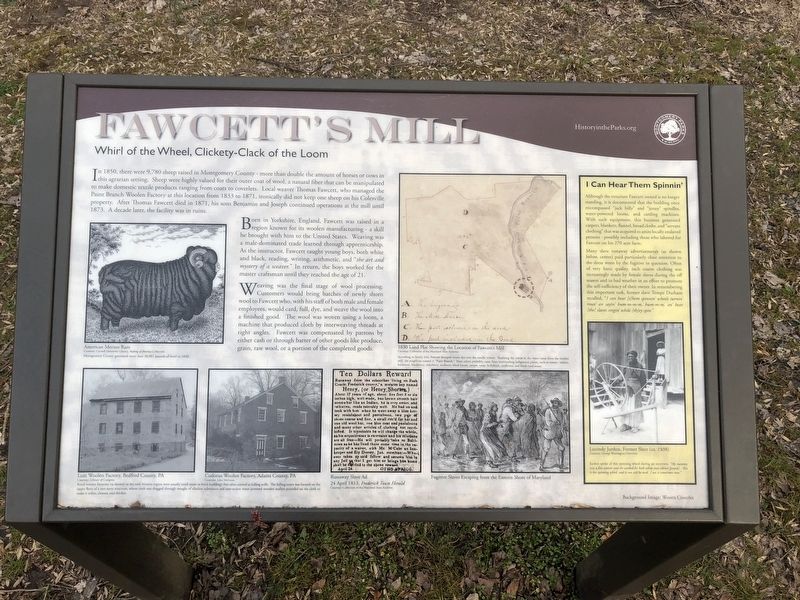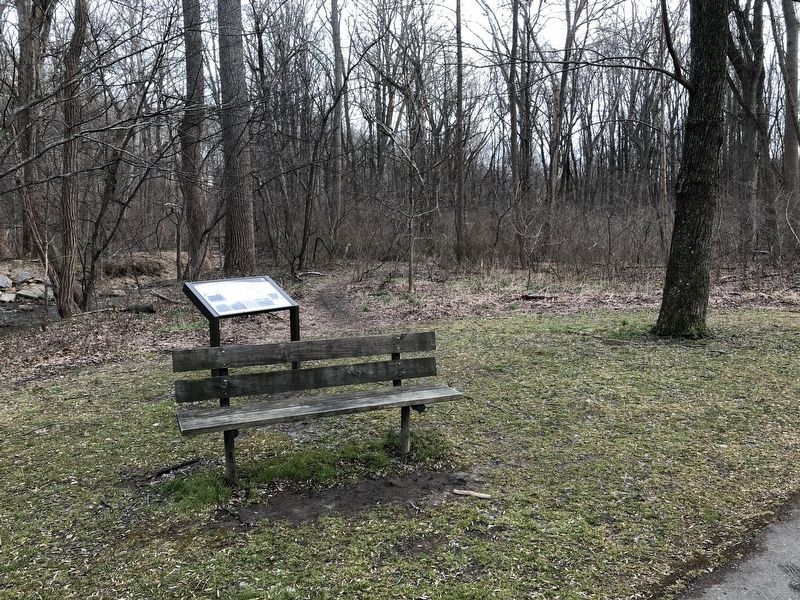Colesville in Silver Spring in Montgomery County, Maryland — The American Northeast (Mid-Atlantic)
Fawcett's Mill
Whirl of the Wheel, Clickety-Clack of the Loom
In 1850, there were 9,780 sheep raised in Montgomery County - more than double the amount of horses or cows in this agrarian setting. Sheep were highly valued for their outer coat of wool, a natural fiber that can be manipulated to make domestic textile products ranging from coats to coverlets. Local weaver Thomas Fawcett, who managed the Paint Branch Woolen Factory at this location from 1833 to 1871, ironically did not keep one sheep on his Colesville property. After Thomas Fawcett died in 1871, his sons Benjamin and Joseph continued operations at the mill until 1873. A decade later, the facility was in ruins.
Born in Yorkshire, England, Fawcett was raised in a region known for its woolen manufacturing - a skill he brought with him to the United States. Weaving was a male-dominated trade learned through apprenticeship. As the instructor, Fawcett taught young boys, both white and black, reading, writing, arithmetic, and "the art and mystery of a weaver." In return, the boys worked for the master craftsman until they reached the age of 21.
Weaving was the final stage of wool processing. Customers would bring batches of newly shorn wool to Fawcett who, with his staff of both male and female employees, would card, fully, dye, and weave the wool into a finished good. The wool was woven using a loom, a machine that produced cloth by interweaving threads at right angles. Fawcett was compensated by patrons by either cash or through barter of other goods like produce, grain, raw wool, or a portion of the completed goods.
[Captions:]
According to family lore, Fawcett dumped excess dye into the nearby stream. Realizing the colors in the water came from the woolen mill, the neighbors named it "Pain Branch." These colors probably came from surrounding indigenous plants, such as sumac, walnut, butternut, blackberry, elderberry, mulberry, black locust, yarrow, tansy, hollyhock, sunflower, and black-eyed susan.
Rural woolen factories (as shown) in the mid-Atlantic region were usually small stone or brick buildings that often started as fulling mills. The fulling room was located on the upper floor of a two story structure, where cloth was dragged through troughs of alkaline substances and cam-action water powered wooden mallets pounded on the cloth to make it softer, cleaner and thicker.
[Sidebar:]
Many slave runaway advertisements (as shown below, center) paid particularly close attention to the dress worn by the fugitive in question. Often of a very basic quality, such coarse clothing was increasingly made by female slaves during the off season and in bad weather in an effort to promote the self-sufficiency of their owner. In remembering this important task, former slave Tempe Durham recalled, "I can hear [t]hem spinnin' wheels turnin' roun' an sayin' hum-m-m-m, hum-m-m, an' hear [the] slaves singin' while [th]ey spin."
Jurdon spoke of this spinning wheel during an interview, "My mammy was a fine weaver and she worked for both white and colored [people]. This is her spinning wheel, and it can still be used. I use it sometimes now."
Erected by Montgomery Parks.
Topics. This historical marker is listed in these topic lists: African Americans • Animals • Industry & Commerce. A significant historical date for this entry is April 24, 1813.
Location. 39° 4.598′ N, 76° 58.559′ W. Marker is in Silver Spring, Maryland, in Montgomery County. It is in Colesville. Marker can be reached from Paint Branch Trail east of Tamarack Road, on the left when traveling east. Touch for map. Marker is at or near this postal address: 13505 Collingwood Terrace, Silver Spring MD 20904, United States of America. Touch for directions.
Other nearby markers. At least 8 other markers are within 2 miles of this marker, measured as the crow flies. Snowden's Mill (approx. 0.4 miles away); Edmonston's Mill (approx. 0.6 miles away); Valley Mill (approx. ¾ mile away); a different marker also named Valley Mill (approx. ¾ mile away); Smithville Colored School (approx. one mile away); Khmer Rouge Genocide Memorial (approx. 1.4 miles away); Lee Family Cemetery (approx. 1.7 miles away); The Commonwealth Farm (approx. 1.8 miles away). Touch for a list and map of all markers in Silver Spring.
Credits. This page was last revised on February 21, 2023. It was originally submitted on March 24, 2018, by Devry Becker Jones of Washington, District of Columbia. This page has been viewed 507 times since then and 45 times this year. Photos: 1, 2. submitted on March 24, 2018, by Devry Becker Jones of Washington, District of Columbia. • Andrew Ruppenstein was the editor who published this page.

